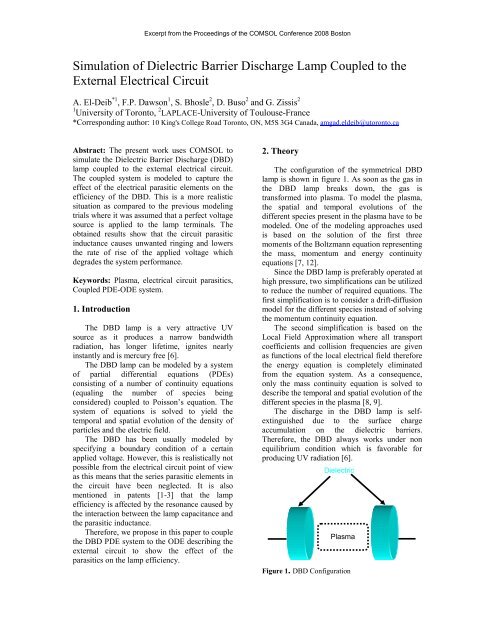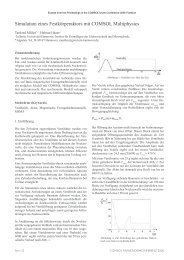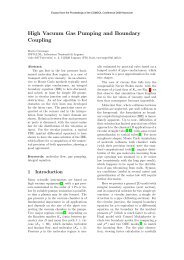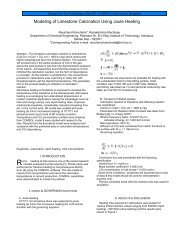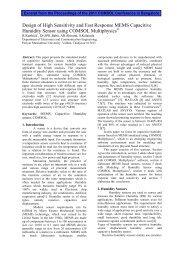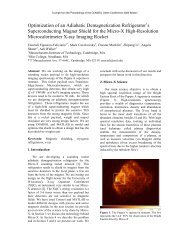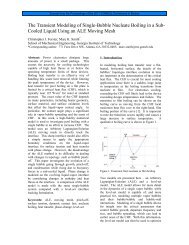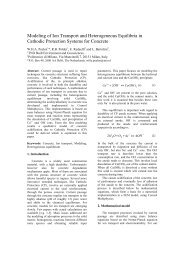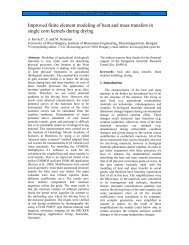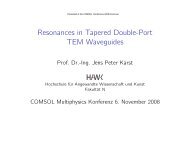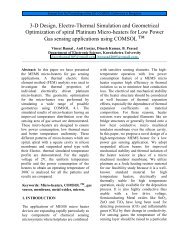Simulation of Dielectric Barrier Discharge Lamp ... - COMSOL.com
Simulation of Dielectric Barrier Discharge Lamp ... - COMSOL.com
Simulation of Dielectric Barrier Discharge Lamp ... - COMSOL.com
Create successful ePaper yourself
Turn your PDF publications into a flip-book with our unique Google optimized e-Paper software.
<strong>Simulation</strong> <strong>of</strong> <strong>Dielectric</strong> <strong>Barrier</strong> <strong>Discharge</strong> <strong>Lamp</strong> Coupled to the<br />
External Electrical Circuit<br />
A. El-Deib *1 , F.P. Dawson 1 , S. Bhosle 2 , D. Buso 2 and G. Zissis 2<br />
1 University <strong>of</strong> Toronto, 2 LAPLACE-University <strong>of</strong> Toulouse-France<br />
*Corresponding author: 10 King's College Road Toronto, ON, M5S 3G4 Canada, amgad.eldeib@utoronto.ca<br />
Abstract: The present work uses <strong>COMSOL</strong> to<br />
simulate the <strong>Dielectric</strong> <strong>Barrier</strong> <strong>Discharge</strong> (DBD)<br />
lamp coupled to the external electrical circuit.<br />
The coupled system is modeled to capture the<br />
effect <strong>of</strong> the electrical parasitic elements on the<br />
efficiency <strong>of</strong> the DBD. This is a more realistic<br />
situation as <strong>com</strong>pared to the previous modeling<br />
trials where it was assumed that a perfect voltage<br />
source is applied to the lamp terminals. The<br />
obtained results show that the circuit parasitic<br />
inductance causes unwanted ringing and lowers<br />
the rate <strong>of</strong> rise <strong>of</strong> the applied voltage which<br />
degrades the system performance.<br />
Keywords: Plasma, electrical circuit parasitics,<br />
Coupled PDE-ODE system.<br />
1. Introduction<br />
Excerpt from the Proceedings <strong>of</strong> the <strong>COMSOL</strong> Conference 2008 Boston<br />
The DBD lamp is a very attractive UV<br />
source as it produces a narrow bandwidth<br />
radiation, has longer lifetime, ignites nearly<br />
instantly and is mercury free [6].<br />
The DBD lamp can be modeled by a system<br />
<strong>of</strong> partial differential equations (PDEs)<br />
consisting <strong>of</strong> a number <strong>of</strong> continuity equations<br />
(equaling the number <strong>of</strong> species being<br />
considered) coupled to Poisson’s equation. The<br />
system <strong>of</strong> equations is solved to yield the<br />
temporal and spatial evolution <strong>of</strong> the density <strong>of</strong><br />
particles and the electric field.<br />
The DBD has been usually modeled by<br />
specifying a boundary condition <strong>of</strong> a certain<br />
applied voltage. However, this is realistically not<br />
possible from the electrical circuit point <strong>of</strong> view<br />
as this means that the series parasitic elements in<br />
the circuit have been neglected. It is also<br />
mentioned in patents [1-3] that the lamp<br />
efficiency is affected by the resonance caused by<br />
the interaction between the lamp capacitance and<br />
the parasitic inductance.<br />
Therefore, we propose in this paper to couple<br />
the DBD PDE system to the ODE describing the<br />
external circuit to show the effect <strong>of</strong> the<br />
parasitics on the lamp efficiency.<br />
2. Theory<br />
The configuration <strong>of</strong> the symmetrical DBD<br />
lamp is shown in figure 1. As soon as the gas in<br />
the DBD lamp breaks down, the gas is<br />
transformed into plasma. To model the plasma,<br />
the spatial and temporal evolutions <strong>of</strong> the<br />
different species present in the plasma have to be<br />
modeled. One <strong>of</strong> the modeling approaches used<br />
is based on the solution <strong>of</strong> the first three<br />
moments <strong>of</strong> the Boltzmann equation representing<br />
the mass, momentum and energy continuity<br />
equations [7, 12].<br />
Since the DBD lamp is preferably operated at<br />
high pressure, two simplifications can be utilized<br />
to reduce the number <strong>of</strong> required equations. The<br />
first simplification is to consider a drift-diffusion<br />
model for the different species instead <strong>of</strong> solving<br />
the momentum continuity equation.<br />
The second simplification is based on the<br />
Local Field Approximation where all transport<br />
coefficients and collision frequencies are given<br />
as functions <strong>of</strong> the local electrical field therefore<br />
the energy equation is <strong>com</strong>pletely eliminated<br />
from the equation system. As a consequence,<br />
only the mass continuity equation is solved to<br />
describe the temporal and spatial evolution <strong>of</strong> the<br />
different species in the plasma [8, 9].<br />
The discharge in the DBD lamp is selfextinguished<br />
due to the surface charge<br />
accumulation on the dielectric barriers.<br />
Therefore, the DBD always works under non<br />
equilibrium condition which is favorable for<br />
producing UV radiation [6].<br />
<strong>Dielectric</strong><br />
Plasma<br />
Figure 1. DBD Configuration
3. Governing Equations<br />
The physics <strong>of</strong> the DBD can be described<br />
using a system <strong>of</strong> coupled PDEs. Each particle<br />
included in the chemical model <strong>of</strong> the gas is<br />
described by a continuity equation. The<br />
continuity equations depend on the electric field<br />
E. Therefore, these equations are coupled to<br />
Poisson’s equation to solve for E and the density<br />
<strong>of</strong> the different particles. The external circuit is<br />
described by an ODE. The governing equations<br />
are:<br />
∂n<br />
j<br />
1. Continuity equation: + ∇ ⋅ Γj<br />
∂t<br />
= S (1) j<br />
n j Volume density <strong>of</strong> particle j<br />
S j<br />
Source term for the particle j which<br />
describes the net rate <strong>of</strong> generation <strong>of</strong><br />
particle j.<br />
Γ Flux <strong>of</strong> particle j<br />
j<br />
The continuity equations are only solved in the<br />
gas domain.<br />
2. Poisson’s equation: ∇ ⋅ ε E = ρ (2)<br />
v<br />
where E = −∇ V , V is the electric potential.<br />
ε <strong>Dielectric</strong> permittivity<br />
ρ Net volume charge density<br />
v<br />
Poisson’s equation is solved in the dielectric<br />
barriers and in the gas.<br />
3. Kirch<strong>of</strong>f’s Voltage Law:<br />
The external circuit used for demonstration<br />
purposes is shown in figure 2. It is described by<br />
an ODE which is obtained from Kirch<strong>of</strong>f’s<br />
voltage law (KVL).<br />
di DBD<br />
v s = R si<br />
DBD + L s + v<br />
(3)<br />
DBD<br />
dt<br />
Figure 2. DBD connected to external circuit<br />
4. Numerical Model<br />
The numerical model that describes the DBD<br />
is based on the chemical species included in the<br />
chemical model. Figure A.1 in Appendix A<br />
shows the different species with the chemical<br />
reactions that either generate or destroy the<br />
corresponding particle. The chemical reactions<br />
determine the source term Sj in the continuity<br />
equation (1) <strong>of</strong> each particle.<br />
The flux <strong>of</strong> particle j is <strong>com</strong>posed <strong>of</strong><br />
diffusion and drift <strong>com</strong>ponents and is given by<br />
equation (4).<br />
Γ = − ∇n<br />
+ sign ( q ) n µ E (4)<br />
j<br />
D j j<br />
i j j<br />
D j Diffusion coefficient <strong>of</strong> particle j<br />
µ j Mobility <strong>of</strong> particle j<br />
q j Charge <strong>of</strong> particle j<br />
The transport coefficients are function <strong>of</strong> the<br />
electrical field as a result <strong>of</strong> the Local Field<br />
Approximation [8]. These functions are shown in<br />
figure A.4 and A.5 in Appendix A.<br />
Regarding Poisson’s equation (2) ρ is the<br />
v<br />
net volume charge density due to electrons and<br />
positively charged ions. The volume charge is<br />
given by ρ v = q( n i + n i 2 − n e ) , where ne, ni<br />
and ni2 are the densities <strong>of</strong> the electrons, ions and<br />
molecular ions respectively<br />
4.1 Boundary Conditions<br />
The boundary conditions used in this model<br />
are as follows:<br />
a) Boundary conditions on the continuity<br />
equations:<br />
A specific flux at both boundaries <strong>of</strong> the gas<br />
volume (dielectric surface) for electrons and ions<br />
[10]:<br />
Γ = K n − K n + K n n (5)<br />
e<br />
sads<br />
e<br />
sdes<br />
Γ = K n + K n n<br />
(6)<br />
i sads i srec i se<br />
Γ i 2 = K sads n i 2 + K srec n i 2 n<br />
(7)<br />
se<br />
nse and nsi are the accumulated surface<br />
electron and ion density respectively at the<br />
dielectric surfaces. These surface densities are<br />
governed by the following ODEs:<br />
dn se<br />
dt<br />
= K sads n e − K sdes n se − K srec n se n (8)<br />
i<br />
se<br />
srec<br />
e<br />
si
dn si<br />
= K sads n i − K srec n si n<br />
(9)<br />
e<br />
dt<br />
The K coefficients describe the rate <strong>of</strong> the<br />
different physical processes occurring due to the<br />
interaction <strong>of</strong> the electrons and ions with the<br />
dielectric barrier material. The values used are<br />
given in the Appendix.<br />
The boundary condition for the rest <strong>of</strong> the<br />
particles is zero density at the dielectric surfaces.<br />
b) Boundary Conditions on Poisson’s equation:<br />
A flux discontinuity occurs at both dielectric<br />
surfaces because <strong>of</strong> the net accumulated surface<br />
charges ρ s :<br />
1 E1 − ε 2E<br />
2 ρ s<br />
(10)<br />
ε =<br />
One <strong>of</strong> the outer electrodes has a zero<br />
potential. Electric field is specified at the other<br />
outer electrode to perform an injected current<br />
1<br />
condition: E s = ∫ i DBD dt<br />
(11)<br />
Aε<br />
d<br />
ε d = ε oε<br />
, r ε is the relative permittivity <strong>of</strong><br />
r<br />
the dielectric material used. A is the cross section<br />
area<br />
4.2 Initial Conditions<br />
The initial condition for the ion ni and<br />
electron ne densities is an equal and uniform<br />
density across the gap length. Both densities<br />
have to be the same to preserve the electroneutrality<br />
<strong>of</strong> the gas. For the rest <strong>of</strong> the variables,<br />
the initial condition is zero.<br />
4.3 Energy Calculations<br />
The input energy in one cycle <strong>of</strong> length T is<br />
calculated as<br />
E<br />
in<br />
=<br />
t0<br />
+ T<br />
∫<br />
t 0<br />
v<br />
DBD<br />
i<br />
DBD<br />
dt<br />
(12)<br />
The output optical energy at the wavelength λ<br />
in one cycle is calculated as<br />
t 0 + T L<br />
hc n λ<br />
E out = A ∫ ∫ dx dt<br />
(13)<br />
λ τ<br />
t0<br />
0 λ<br />
h is Planck's constant, c is the speed <strong>of</strong> light, τλ is<br />
the life time <strong>of</strong> the excimer producing the<br />
radiation <strong>of</strong> wavelength λ, nλ is the density <strong>of</strong> the<br />
excimer and L is the gas gap.<br />
Based on the above mentioned equations the<br />
following modules from <strong>COMSOL</strong> are used to<br />
solve the system <strong>of</strong> equations in 1-D Cartesian<br />
space:<br />
I. Transient Diffusion Module<br />
II. Transient Convection Diffusion Module<br />
III. Weak Form Boundary Module<br />
The ODE settings option is used to model the<br />
external circuit and to solve for the input and<br />
output energies.<br />
5. Results<br />
The DBD lamp used in this model has the<br />
following properties:<br />
Gas Xenon<br />
Gas Pressure 400 Torr<br />
Gap length 4 mm<br />
<strong>Barrier</strong> ε r 4<br />
<strong>Barrier</strong> thickness 2 mm<br />
Rs<br />
1 Ω<br />
The voltage waveform <strong>of</strong> the supply Vs is a<br />
unipolar square pulse. Its frequency is 50 kHz<br />
and a peak value <strong>of</strong> 8kV as shown in figure 3.<br />
The first simulation is done with no external<br />
parasitics such that VDBD=Vs. Then, a number <strong>of</strong><br />
simulations is performed with different values<br />
for the external circuit parasitic inductance Ls.<br />
Figure 3 also shows the voltage applied to<br />
the DBD VDBD for different values <strong>of</strong> the external<br />
circuit parasitic inductance. Higher parasitic<br />
inductance results in decreased rate <strong>of</strong> rise <strong>of</strong> the<br />
applied voltage to the DBD and a higher peak<br />
voltage.<br />
The efficiency <strong>of</strong> the DBD lamp is given as a<br />
function <strong>of</strong> the parasitic inductance in figure 4.<br />
Clearly, as the parasitic inductance increases, the<br />
efficiency <strong>of</strong> the lamp decreases.<br />
V<br />
x 104<br />
1.5<br />
1<br />
0.5<br />
0<br />
-0.5<br />
Ls=1e-5 H<br />
Ls=5e-5 H<br />
Ls=1e-4 H<br />
Ls=5e-4 H<br />
Vs<br />
0 0.5 1 1.5 2 2.5<br />
x 10 -5<br />
-1<br />
Tim Tim e e (s (s ec)<br />
ec)<br />
Figure 3. DBD Voltage under different parasitic<br />
inductances
Percentage Percentage Efficiency<br />
Efficiency<br />
100<br />
90<br />
80<br />
70<br />
60<br />
50<br />
40<br />
30<br />
20<br />
0 0.1 0.2 0.3 0.4 0.5 0.6 0.7 0.8 0.9 1<br />
x 10 -3<br />
10<br />
Ls<br />
Figure 4. Effect <strong>of</strong> L s on DBD Efficiency<br />
6. Discussion<br />
As shown in figure 4, the efficiency <strong>of</strong> the<br />
DBD drops from 92% to about 20% if the<br />
external circuit inductance is increased from zero<br />
to 1mH. Usually the DBD power supply circuit<br />
includes a step up transformer. Since the<br />
transformer leakage inductance that appears on<br />
the lamp side is proportional to the turns ratio<br />
squared, the inductance cannot be neglected in<br />
simulating the DBD lamp performance.<br />
The rate <strong>of</strong> rise <strong>of</strong> VDBD as shown in figure 3<br />
decreases as the inductance value is increased. It<br />
is mentioned in [4, 5] that the voltage rate <strong>of</strong> rise<br />
is one <strong>of</strong> the main factors affecting the optical<br />
efficiency <strong>of</strong> the DBD lamp. The fast rise-time <strong>of</strong><br />
the leading edge <strong>of</strong> the applied voltage heats<br />
electrons simultaneously throughout the entire<br />
active volume, allowing the breakdown to occur<br />
in a diffuse form which is favorable condition for<br />
UV production [11].<br />
Another effect <strong>of</strong> the inductance is the<br />
ringing that takes place after the discharge. This<br />
ringing results only in power deposition in the<br />
plasma without producing UV radiation;<br />
therefore the efficiency is also reduced. This has<br />
been also experimentally verified in [1-3].<br />
7. Conclusions<br />
A PDE system describing the DBD lamp<br />
coupled to an external electric circuit has been<br />
solved using <strong>COMSOL</strong>. Modeling the coupled<br />
system shows the effect <strong>of</strong> the parasitic<br />
inductance on the DBD performance.<br />
Modeling the coupled system is also<br />
beneficial to the power supply designer as this<br />
provides better insight for determining the<br />
required ratings for the devices that are used in<br />
the power supply.<br />
8. References<br />
1. Masashi Okamoto and Kenichi Hirose, “Light<br />
source using dielectric barrier discharge lamp”,<br />
US patent no. 6239559, (2001).<br />
2. Masashi Okamoto and Kenichi Hirose,<br />
“<strong>Dielectric</strong> barrier discharge lamp light source”,<br />
US patent no. 6369519, (2002)<br />
3. Takahiro Hiraoka and Masashi Okamoto,<br />
“Device for operating a dielectric barrier<br />
discharge lamp”, US patent no. 6788088, (2004)<br />
4. Yoshihisa Yokokawa, Masaki Yoshioka and<br />
Takafumi Mizojiri, “Device for operation <strong>of</strong> a<br />
discharge lamp”, US patent no. 6084360, (2000)<br />
5. H. Akashi, A. Oda, Y. Sakai, “Modeling <strong>of</strong><br />
glow like discharge in DBD Xe excimer lamp”,<br />
11 th International Symposium on the Science and<br />
Technology <strong>of</strong> Light Sources, Shanghai, China,<br />
20 th -24 th May 2007<br />
6. U. Kogelschatz, <strong>Dielectric</strong>-barrier <strong>Discharge</strong>s:<br />
Their History, <strong>Discharge</strong> Physics, and Industrial<br />
Applications, Plasma Chemistry and Plasma<br />
Processing, 23 No.1, 1-46 (2003)<br />
7. J. A. Bittencourt, Fundamentals <strong>of</strong> Plasma<br />
Physics, Springer-Verlag, New York (2004)<br />
8. G. E. Georghiou, A. P. Papadais, R. Morrow<br />
and A. C. Metaxas, “Numerical modeling <strong>of</strong><br />
atmospheric pressure gas discharges leading to<br />
plasma production,” J. Phys. D: Appl. Phys., 38,<br />
R303-R328(2005)<br />
9. B. Eliasson and U. Kogelschatz, Modeling and<br />
Applications <strong>of</strong> Silent <strong>Discharge</strong> Plasmas, IEEE<br />
Transactions on Plasma Science, 19 No. 2, 309-<br />
323 (1991)<br />
10. S. Bhosle, G. Zissis, J.J. Damelincourt, A.<br />
Capdevila, "A new approach for boundary<br />
conditions in dielectric barrier discharge<br />
modeling", XVI International Conference on<br />
Gas <strong>Discharge</strong>s and their Applications -<br />
September-11-15, 2006, Xian (China)<br />
11. R. Mildren and R. Carman, Enhanced<br />
performance <strong>of</strong> a dielectric barrier discharge<br />
lamp using short-pulsed excitation, J. Phys. D:<br />
Appl. Phys., 34, L1-L6 (2004)<br />
12. A. Oda, Y. Sakai, H. Akashi, H. Sugawara,<br />
One-dimensional modeling <strong>of</strong> low frequency and<br />
high-pressure Xe barrier discharges for the<br />
design <strong>of</strong> excimer lamps, J. Phys. D: Appl.<br />
Phys., 32, 2726-2736 (1999)
13. "The Siglo Database", CPAT and Kinema<br />
S<strong>of</strong>tware, 1995.<br />
10. Appendix A<br />
A simplified model <strong>of</strong> the Xenon atom, with<br />
only three excited states is considered in this<br />
work. The metastable state 3 P2 <strong>of</strong> Xenon is<br />
named Xe met<br />
*<br />
, the resonant state 3 P1 is Xe res<br />
*<br />
and all the other excited states are gathered and<br />
designated by Xe exc<br />
* . Figure A.1 presents the<br />
chemical model adopted in the simulations.<br />
All the reaction rates <strong>com</strong>e from [12].<br />
Collision frequencies and direct ionization<br />
coefficient αidir have been calculated using the<br />
s<strong>of</strong>tware package Bolsig [13]. The step<br />
ionization coefficient Kipal is taken from [10].<br />
The direct and step ionization coefficients are<br />
shown in figures A.2 and A.3 respectively as<br />
functions <strong>of</strong> E/P where E is the electric field and<br />
P is the pressure <strong>of</strong> the Xenon gas.<br />
The source term Sj in the continuity equation<br />
is formulated from the chemical reactions as the<br />
product <strong>of</strong> the different species densities<br />
involved in the reaction multiplied by the rate<br />
coefficient which represents the probability or<br />
the rate <strong>of</strong> this reaction.<br />
The electron mobility and diffusion<br />
coefficient are obtained from the s<strong>of</strong>tware<br />
program Bolsig [13], whereas the ion diffusion<br />
coefficients and drift velocities are taken from<br />
[12] using a linear interpolation.<br />
Figure A.4 shows the electron mobility and<br />
diffusion coefficient as a function <strong>of</strong> the local<br />
electric field. The diffusion coefficient and the<br />
drift velocity <strong>of</strong> the ions are plotted in figure A.5<br />
as functions <strong>of</strong> the reduced electric field E/N. N<br />
is the density <strong>of</strong> the neutral Xenon atom.<br />
Figure A.1. Chemical model adopted for the modeling<br />
10 2<br />
10 0<br />
10 -2<br />
10 -4<br />
10 -6<br />
10 -8<br />
10 -10<br />
10 -12<br />
10<br />
0 50 100 150 200 250 300<br />
-14<br />
10 -13<br />
10 -14<br />
α idir /P (m -1 .Pa -1 )<br />
E/P (V.m -1 .Pa -1 )<br />
Figure A.2. Direct Ionization Coefficient<br />
10<br />
0 50 100 150 200 250 300<br />
-15<br />
E/P (V.m -1 .Pa -1 )<br />
K ipal (m 3 .s -1 )<br />
Figure A.3. Step Ionization Coefficient<br />
x 104<br />
14<br />
12<br />
10<br />
8<br />
6<br />
4<br />
2<br />
0<br />
0 500 1000 1500 2000 2500 3000<br />
E/P (V.m -1 .Pa -1 )<br />
D e .P (Pa.m 2 .s -1 )<br />
µ e .Px50 (Pa.m 2 .V -1 .s -1 )<br />
Figure A.4. Electron Transport Coefficients
1400<br />
1200<br />
1000<br />
800<br />
600<br />
400<br />
200<br />
D i (Xe + )x2.10 4 (m 2 .s -1 )<br />
D (Xe<br />
+<br />
)x2.10<br />
4<br />
(m<br />
2<br />
.s<br />
-1<br />
)<br />
i 2<br />
µ i .E(Xe + ) (m.s -1 )<br />
+ -1<br />
µ .E(Xe ) (m.s )<br />
i 2<br />
0<br />
0 0.1 0.2 0.3 0.4 0.5 0.6 0.7 0.8 0.9 1<br />
E/N (V.m 2 )<br />
Figure A.5. Ion Transport Coefficients<br />
x 10 -18<br />
The K coefficients used in the flux boundary<br />
conditions for the electrons and ions have the<br />
following the values:<br />
Ksads<br />
Ksdes<br />
Ksrec<br />
10 20<br />
10 10<br />
100<br />
A list <strong>of</strong> the variables included in this work<br />
with the symbol used in the Comsol model is<br />
given in table 1.<br />
Table 1: List <strong>of</strong> Variables<br />
Variable Name Symbol<br />
Voltage PotentielM10<br />
Electron Density ElectronM10<br />
Ion Density IonXeM10<br />
Molecular Ion Density IonXe2M10<br />
Xe met<br />
*<br />
XeMetM10<br />
XeResM10<br />
Xe res<br />
*<br />
Xe exc<br />
* XeExcM10<br />
Excimer (1Σ+u) Exci1SM10<br />
Excimer (3Σ+u) Exci3SM10<br />
Excimer (O+u) ExciOuM10<br />
Electron Surface Density ElectronSurfM10<br />
Ion Surface Density ChargePosSurfM10<br />
i_DBD DBD input current<br />
V_DBD DBD voltage


